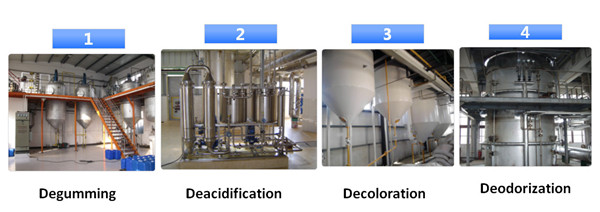
The complete refining process of palm oil is: degumming, deacidification, decolorization and deodorization. Among them, deacidification is an important step in the palm oil refining process, and it is also an essential step. The quality of the deacidification effect directly affects the quality and selling price of palm oil. So how can we complete the deacidification section? What are the factors that affect palm oil alkali refining and deacidification? Here, I will give you a simple science popularization:
1. Alkali and its dosage
Alkali includes caustic soda (NaOH), KOH, Ca(OH)2, Na2CO3, etc.
The total alkali consumption during alkali refining: the theoretical alkali amount for neutralizing free fatty acids; the c amount of alkali added to achieve the process requirements.
①Theoretical alkali content—calculated based on crude oil acid value or free fatty acid percentage.
GNaOH theory = 0.1421 × G oil × FFA%
② C amount of alkali-in order to compensate for the theoretical amount of alkali consumed by decomposition and condensation of other impurities, saponification of neutral oil, and inclusion by the soap film.
Intermittent caustic refining is generally 0.05% to 0.25% of the oil volume, and crude oil with poor quality can be controlled within 0.5%; for continuous caustic refining, the amount of alkali c is generally 10% to 50% of the theoretical alkali content.
The relationship between the amount of alkali and the refining consumption (the curve of the appropriate amount of alkali in the fully enclosed fast mixing continuous alkali refining process
2. Lye concentration
Basis for the selection of lye concentration:
The acid value of the oil (higher acid value has a higher concentration, and vice versa);
Saponification loss of neutral oil;
The consistency of soap feet;
Operating temperature (high temperature light alkali, low temperature concentrated alkali);
Degree of decolorization of crude oil.
3. Operating temperature
Initial temperature: Avoid saponification of neutral oil at low temperature when alkali is added.
Final temperature: After the reaction, higher temperature during oil-soap nugget separation can accelerate the agglomeration of soap nuggets to release neutral oil and facilitate the separation of oil-soap nuggets.
The centrifuge operates continuously, and the separation temperature is generally 80-90°C. The alkali mixing temperature is generally about 50°C.
4. Operating time
The influence of operating time on the effect of alkali refining is mainly reflected in the loss of neutral oil saponification and the comprehensive de-impurity effect. The longer the contact time between oil and alkali, the greater the probability of neutral oil being saponified; but it is beneficial to the removal of other impurities and the change of oil color.
5. Mixing and stirring
When adding alkali, the intensity of mixing or stirring should be strong to make the alkali liquid highly dispersed in the oil phase. When the soap particles flocculate, the mixing and stirring intensity should be gentle.
6. The impact of impurities
For example, peptic impurities can promote long-lasting emulsification in alkali refining; for example, gossypol and other pigments increase the amount of alkali used.
Soft water should be used to prepare alkaline solution.
7. separation
The oil-soap separation effect depends on the flocculation of the soapstock, the consistency of the soapstock, the separation temperature and the settling time. Continuous centrifugal separation is also affected by separator performance, material flow, feed pressure and light phase (oil) outlet pressure.
8. Washing and drying
Reduce residual soap and free alkali in alkali refining by washing with hot water.
The washing operation temperature is generally around 85°C, and the amount of water added is 10% to 15% of the oil. One wash water can use a mixed dilute solution of salt and alkali, and reduce the stirring speed. To prevent emulsification.
Precautions! ! !
Vacuum drying should be used for the drying of alkali refining.
Copyright © Henan Zhongxing Grain And Oil Machinery Co.,Ltd. All Rights Reserved. Powered by MetInfo